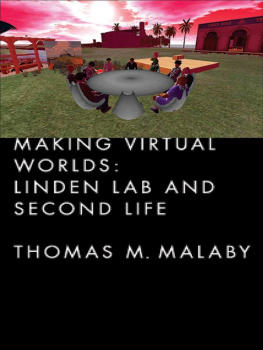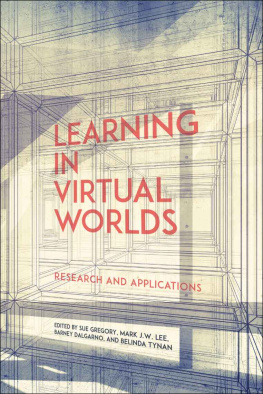Ning Gu, Mary Lou Maher
Designing Adaptive Virtual Worlds

Published by De Gruyter Open Ltd, Warsaw/Berlin

This work is licensed under the Creative Commons Attribution-NonCommercial-NoDerivs 3.0 license, which means that the text may be used for non-commercial purposes, provided credit is given to the author. For details go to http://creativecommons.org/licenses/by-nc-nd/3.0/.
Complimentary Copy Not for Sale
Copyright 2014 Ning Gu and Mary Lou Maher
ISBN: 978-3-11-036765-2
e-ISBN: 978-3-11-036766-9
epub-ISBN: 978-3-11-039921-9
Bibliographic information published by the Deutsche Nationalbibliothek
The Deutsche Nationalbibliothek lists this publication in the Deutsche Nationalbibliografie; detailed bibliographic data are available in the Internet at http://dnb.dnb.de.
Managing Editor: Monika Michaowicz
Associate Editor: Davina Jackson
Language Editor: Andrew Kerber
www.degruyteropen.com
Cover illustration: Ning Gu and Noel Yaxley
Contents
Part I: Introduction
1 Introduction
The boundary between our physical environment and the digital world is becoming increasingly blurred as we move more and more of our personal communication, health records, bank details, professional interactions, educational materials and records, and entertainment online. On one extreme, we have a physical world void of any digital content, an increasingly small part of the developed world, but still present. On the other extreme we have digital personas that exist only in virtual worlds such as Second Life. These two extremes hardly characterize the complexity of the boundary between the two, but they allow us to think about what may be common in the extremes.
The boundary can be described as a sense of immersion or a focus of attention that is often crossed: for example, we may be interacting with a friend or colleague on Skype, where physical and gestural interaction affect digital content. This book explores one extreme, the intentional design of virtual worlds to accommodate our increasing presence in digital environments that extend our sense of place. This focus on place provides a basis for integrating our digital lives into our physical lives by building on our existence as physical beings. By focusing on the design of place in virtual worlds, we can better accommodate the myriad of technologies that lie between the extreme of a physical place void of digital content and a purely digital world void of physical existence.
1.1 Why Adaptive Virtual Worlds?
Virtual worlds provide immersive experiences in another world that is inhabited by other people represented as avatars. While this has been a popular arena for massive multiplayer online role-playing games and entertainment have had a difficult time achieving recognition as a widely-used technology. We do not attempt to address the issue of the viability of virtual worlds, but instead present a focus on the design of adaptive virtual worlds as a basis for the future of virtual worlds. We present design principles that are based on how virtual worlds are similar yet distinct from the physical world. A virtual world can be familiar in its reference to the physical world, but can be different because it is not restricted by the physics of the physical world. In particular, we focus on how virtual worlds can be designed to adapt to the needs of their inhabitants.
In light of the rapid proliferation of technologies that enhance our physical existence with smart phones, smart clothing, smart homes, smart buildings, we see an opportunity to extend the design of physical environments beyond the digital enhancement of physical devices and places, to the design of virtual worlds that can extend our physical world using the metaphor of place. The early history of virtual worlds has shown that these new places can provide many of the affordances of the physical world that may be too expensive or not accessible to a large percentage of the population. As computing devices, including desktop computers, laptops, tablets, and smart phones, are becoming available to a significant percentage of the population in both first- and third-world countries, this emphasis on designing adaptive virtual worlds provides a forum for extending the ability for people to have meaningful experiences such as online education. Some online education models include MOOCs, where the number of students in a single class be in the hundreds of thousands, and crowdsourcing initiatives, such as citizen science, where the number of participants can increase to millions. More generally, we are seeing the development of communities whose focus and interests are not based on their physical location, yet their personal existence and experiences are physical. By pursuing the design of adaptive virtual worlds, we hope to raise an awareness of the potential and importance of both the adaptive aspects and the need for design principles.
1.2 Why Design Places?
Designing places has a history significantly longer than the history of virtual worlds. We focus on the design of place in the context of virtual worlds in order to distinguish the content of this book from other books that focus on the design of the 3D models or the technology to support a virtual world. With a focus on place, we can merge the design principles that have evolved over a long history of architecture with the principles of new technology that make virtual worlds possible. Architectural design has often been considered to be essentially about place making for built environments. Through designing places, this book aims to build on the rich knowledge base of architectural design and extend and adapt it for virtual worlds.
We take into consideration the differences between designing with physical materials and designing with digital content. An example of a design domain that has principles similar to designing virtual worlds is the design of web sites. We separate the representation of the content of the virtual world from its dynamic, adaptive, and interactive characteristics, allowing us to represent place as something that changes over time as needed. In the design of a web site, the content is specified within the HTML tags, where the tags define the categories of content. The layout and design style of the web site is described by the CSS rules, where categories of content are given specific rules for their appearance and location on the web page. The interactivity and dynamics of the web site are specified in JavaScript, Ajax, JQuery or other scripting languages for client-side processing and in PHP, Ruby, Python or other languages for server-side processing. These distinctions are similar to the design of virtual worlds, where the content, style, and interaction/dynamics are defined as the materials of design. The difference is that web sites use the metaphor of documents as the basis for design, and we use the metaphor of place in designing virtual worlds. In this book, we define the materials for designing virtual worlds in terms of the content or objects in the world as 3D models; the layout of a 3D place as layout rules; the design and arrangement of the objects in the place as object design rules; the circulation and accessibility of the place as navigation rules; the dynamics of the objects and place as interaction rules in a grammar; and the ability to be adaptive by wrapping an agent model around the grammar that senses and responds to the needs of the users in the virtual world.
1.3 Overview of This Book
Next page












